


Proof of Useful Work
Guest post from Robert McTague
With the exception of Bitcoin, the broader industry has mostly moved to proof of stake, layer 2s, and other consensus mechanisms that don’t require industrial-scale electricity consumption. This made sense — why burn megawatts solving arbitrary puzzles when you could achieve consensus through staking?
But 2024’s AI boom is changing this calculus. AI workloads require exactly the kind of distributed, parallel computation that characterizes proof of work mining. At the same time, we now have millions of consumer devices capable of meaningful AI computation. NVIDIA shipped 30 million consumer GPUs in 2023, while Apple sells more than 20 million Macs with M-series chips annually. That’s several million A100-equivalents of compute entering the market each year.
The opportunity is obvious. Replace meaningless hash functions with useful AI computation. Instead of miners solving SHA-256 hashes, they could train models or run inference while simultaneously securing blockchain networks. The same computational infrastructure could also generate zero-knowledge proofs, which rely on similarly intensive polynomial operations and are increasingly in demand as privacy becomes critical for enterprise applications. This isn’t just an efficiency improvement but a fundamental change to proof of work’s value proposition.
The Decentralized AI Compute Landscape
Understanding this shift requires mapping the current decentralized AI ecosystem. The AI workflow breaks into two main components: training (exposing models to datasets so they learn patterns) and inference (using trained models to generate outputs). Both involve distributed, parallel computation — exactly what proof of work miners have been doing, minus the useful output.
The ecosystem has organized into three categories:
Training networks (Ambient, w.ai, Nous, Templar, Pluralis, Gensyn, Prime Intellect) tackle the challenge of distributed model training. These platforms coordinate gradient computation, parameter updates, and model synchronization across thousands of participants. It’s technically complex. Imagine orchestrating a symphony where every musician has different latency and some randomly disconnect mid-performance.
Inference networks (w.ai, Nineteen, Hyperbolic, Venice, Ritual) focus on serving trained models efficiently. Rather than centralizing inference in data centers, these networks distribute model serving across nodes, reducing costs and improving accessibility. Think of it as edge computing for AI, bringing computation closer to users.
GPU marketplaces (io.net, w.ai, Prime Intellect, Akash, Render) create liquid markets for computational resources. These platforms let hardware owners monetize idle capacity while giving developers on-demand access to distributed compute. Many training and inference networks rely on these marketplaces as their underlying infrastructure layer.
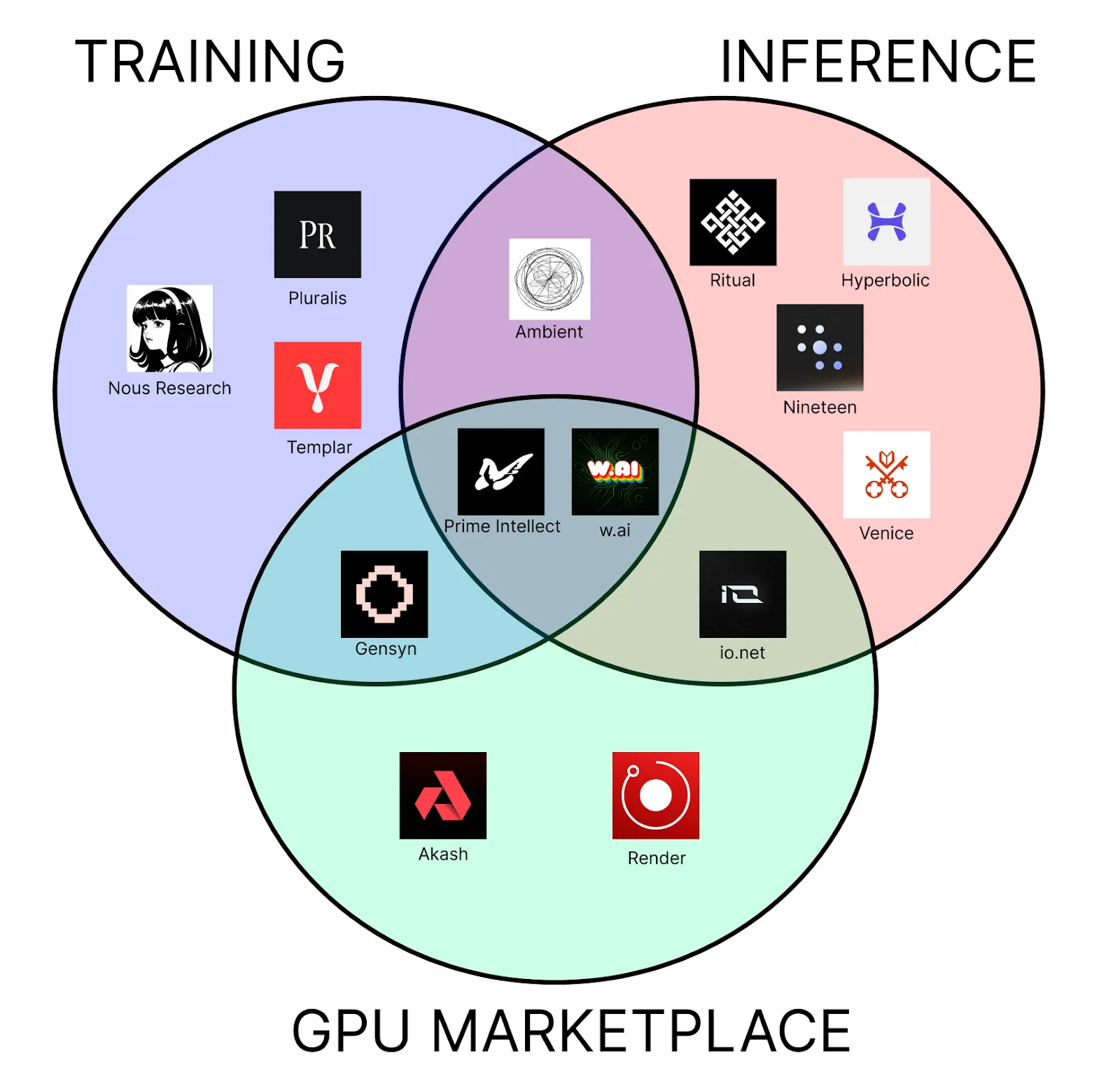
This taxonomy matters because it shows how the pieces fit together. GPU marketplaces provide raw compute, training networks use that compute to build models, and inference networks deploy those models. Each layer creates value, and each could potentially integrate with proof of work consensus mechanisms.
w.ai: The Consumer Compute Layer
The project leverages experience from WOMBO, which reached over 200 million users, to create a simple client installation process. Users download the w.ai client with a few clicks, similar to installing Spotify or Zoom, with no crypto knowledge required. The client runs in the background, monetizing idle GPU cycles by contributing to AI workloads. With over 3,500 machines online, w.ai demonstrates retail appetite for participating in distributed AI computation.
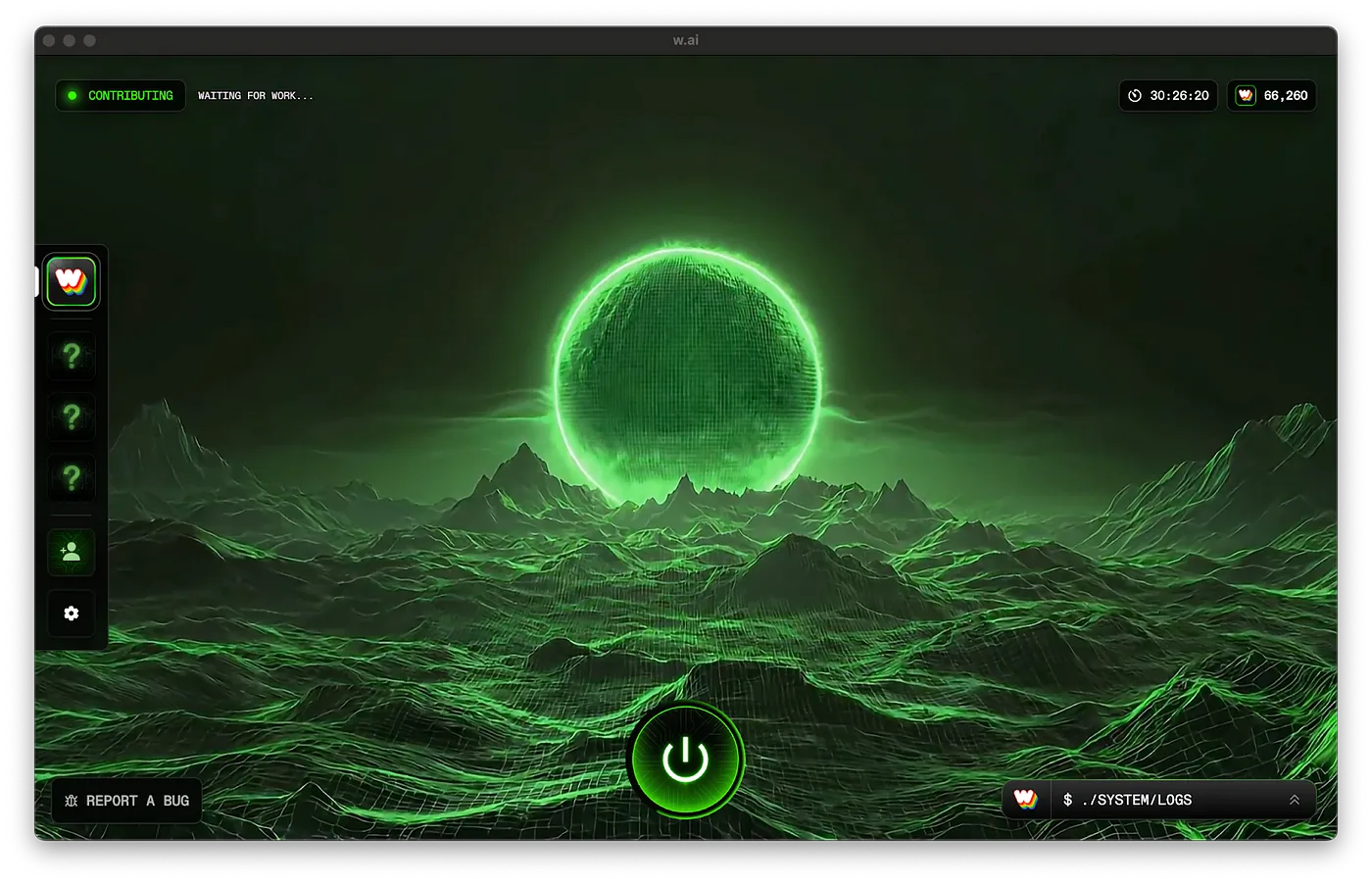
This approach will expand the pool of compute for AI-powered proof of work networks. The same consumer devices performing inference tasks could participate in proof of work consensus mechanisms that reward AI computation. w.ai’s strategy recognizes that most people won’t interact with blockchain protocols but will participate if the experience is seamless and rewarding.
GPU marketplaces like Render could integrate w.ai’s consumer hardware pool for capacity. Inference networks like Ritual could route queries through w.ai’s device network for latency and costs. Training networks like Prime Intellect could access w.ai’s distributed hardware for model training.
Prime Intellect: Proving Distributed Training Works
Prime Intellect trained INTELLECT-1, a 10-billion-parameter model, entirely through distributed methods in October 2024. This is a production-scale model trained across hardware from different contributors around the world.
The breakthrough comes from solving the coordination problem that has plagued distributed AI training. Traditional approaches require constant communication between all participants, creating massive bandwidth bottlenecks. Prime Intellect’s solution works like organizing separate study groups that only meet occasionally to share notes. They create “islands” of connected devices that work independently most of the time, then synchronize their progress every few hundred training steps.
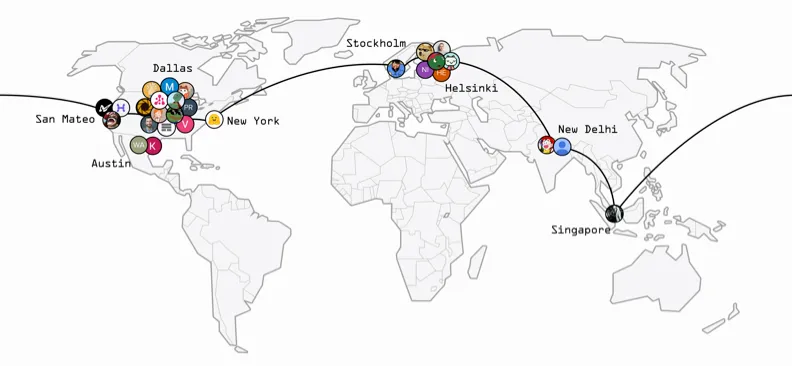
Prime Intellect built custom software that handles nodes joining and leaving the network mid-training. They created compression techniques that dramatically reduce the amount of data that needs to be shared between participants. The system automatically routes around failed connections and optimizes bandwidth usage across different internet providers and geographical locations.
While Prime Intellect doesn’t use this computation for blockchain consensus, they’ve proven the underlying premise of AI-powered proof of work. Distributed participants can collaborate on commercially valuable AI tasks across unreliable internet connections. The same coordination mechanisms that enable their distributed training could secure blockchain networks while producing useful AI models.
Ambient: AI Computation as Consensus
Ambient represents the first implementation of true AI-secured proof of work through their “proof of logits” mechanism. This isn’t AI computation alongside consensus. The AI computation is the consensus.
Here’s how it works: miners compete to generate text using a 600+ billion parameter language model. When AI models generate text, they produce “logits” at each step. These are numerical scores showing confidence levels for each possible next word. These logits serve as unique computational fingerprints that prove a specific model generated specific output.
Validators verify this work by checking these logit fingerprints rather than recomputing entire responses. A miner might generate 4,000 tokens of text, but a validator only needs to check one random token by running a single inference step and comparing logits. If they match, the entire output is verified. This maintains Bitcoin’s elegant property where producing work is computationally expensive but verification is cheap.
Beyond inference, miners also participate in training and fine-tuning the network model itself. Through coordinated training runs, the distributed mining network continuously evolves the shared 600+ billion parameter model, creating a self-improving collective intelligence where computational work simultaneously secures the blockchain, produces economically valuable output, and advances AI capabilities.
Ambient builds on Solana’s high-throughput architecture but replaces proof of stake with this AI-based proof of work. By focusing on a single large model rather than fragmented model marketplaces, the system achieves higher miner utilization rates and consistent quality guarantees that agents and applications can rely on.
This represents a new evolution of proof of work — network security, economic value production, and AI advancement unified in a single mechanism where every computation that secures the blockchain also serves real user demand and contributes to the collective intelligence of the network.
Zero-Knowledge Proof of Work
The same logic behind AI-powered proof of work also applies to zero-knowledge proofs. ZK proofs rely on heavy polynomial computation, making them a natural match for distributed PoW systems. As privacy grows more important for businesses and consumers alike, demand for ZK proof generation is soaring.
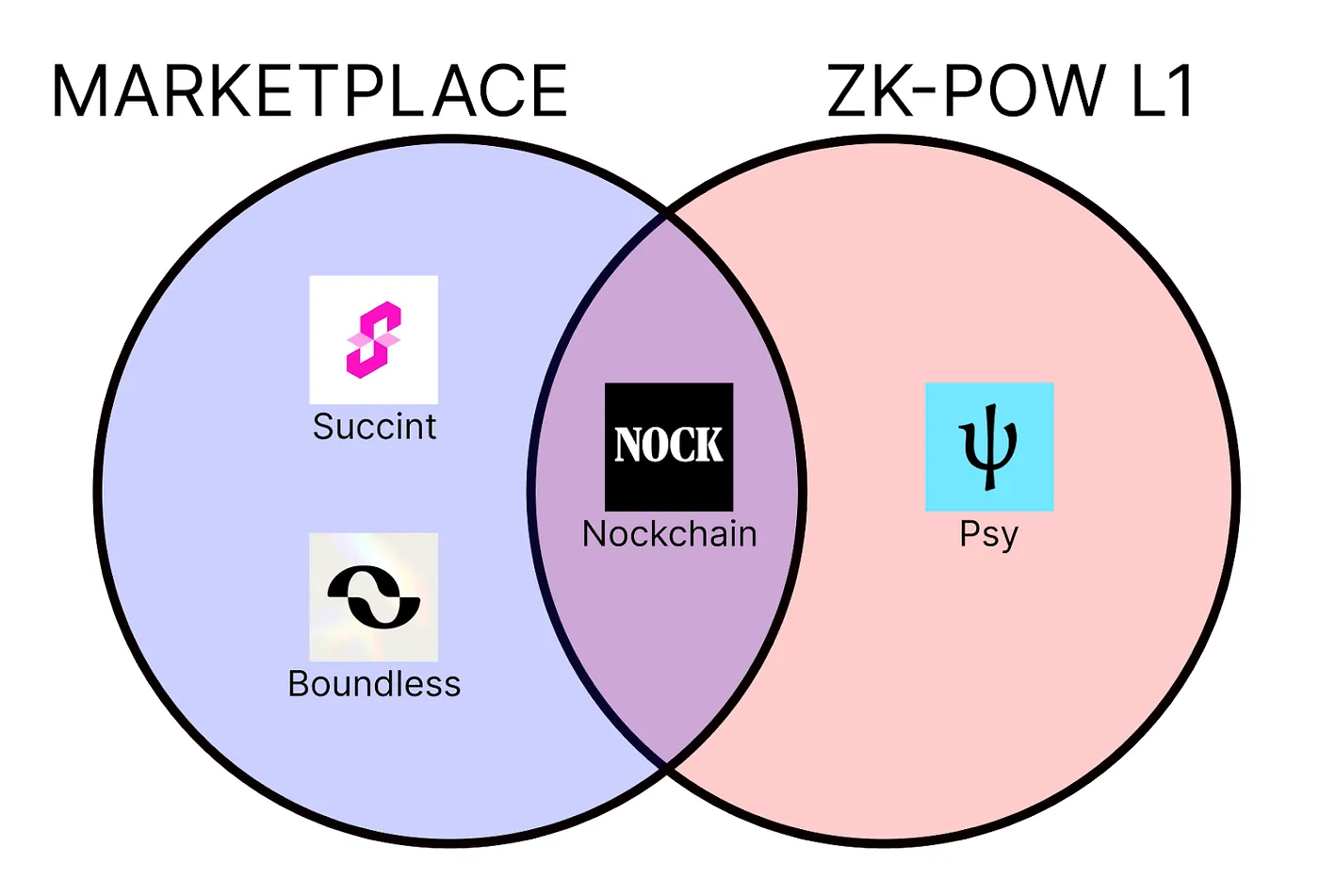
The ZK PoW space now falls into two camps: marketplaces and ZK-PoW layer ones. Some projects blend the two, pairing marketplace economics with blockchain consensus.
Marketplaces
The RISC Zero team has proposed Boundless, a decentralized marketplace that changes how zero-knowledge proofs are generated and consumed. Rather than each application building its own proving infrastructure, Boundless creates a unified market where “provers” (operators of GPUs and commodity hardware) compete for proof generation requests from “requestors.”
The Succinct Prover Network creates a similar marketplace on Ethereum, coordinating distributed provers to generate zero knowledge proofs for any software. Their technology makes proof generation as simple as traditional computing — developers write in common languages like Rust and C++, then deploy programs where provers compete to generate proofs efficiently.
Beyond pure marketplaces, some projects are exploring ways to integrate ZK proof generation more directly into blockchain consensus mechanisms. This represents a fundamental shift from treating proofs as external services toward making them an integral part of network security.
Nockchain: Mining Proofs, Not Hashes
ZK proof-of-work L1s are blockchain networks that build zero-knowledge proof generation into their consensus. Instead of treating ZK proofs as an external service, these networks turn ZK computation into the very “work” that secures the chain, turning security costs into useful output that meets real-world demand.
Nockchain takes a hybrid path, blending ZK proof generation with classic proof-of-work consensus. As the diagram shows, it sits at the overlap of marketplace and blockchain models, acting both as a ZK proving service and as a proof-of-work L1.
On the blockchain side, Nockchain mirrors Bitcoin’s architecture. Miners compete to solve computational puzzles, blocks arrive at regular intervals with automatic difficulty adjustment, and the longest valid chain defines consensus. The twist is that SHA-256 hash puzzles are replaced by ZK proof generation: miners race to produce valid zero-knowledge proofs, and the first one secures the block reward plus transaction fees.
At the same time, Nockchain incentivizes the development of a marketplace for ZK proving. Developers may later pay the protocol to have their computations proven and published as a part of transactions, creating what the team calls “Global-Consensus SNARKs as a Service.” Every computing cycle that secures the network also generates commercially valuable proofs. Block subsidies guarantee baseline demand when external demand is low, while miners earn extra revenue from developer fees.
The system relies on a minimal instruction set that makes proof generation an order of magnitude more efficient than existing alternatives. Developers submit computation requests, miners vie to generate the proofs, and the winning miner both seals the next block and delivers the requested proof.
Psy: Rebuilding Consensus Around ZK Proofs
Psy takes a fundamentally different approach by rebuilding blockchain architecture entirely around zero-knowledge proofs. Rather than retrofitting ZK into existing consensus mechanisms, Psy eliminates traditional consensus altogether — but it’s still fundamentally proof-of-work.
The process begins with users executing transactions locally on their own devices. Each user generates cryptographic proofs that their transactions were executed correctly according to the smart contract code. The network’s role shifts from transaction execution to proof aggregation. Specialized participants collect millions of individual user proofs and recursively combine them into progressively larger proofs. This aggregation work is computationally intensive — it’s the “work” in Psy’s proof-of-work system.
Unlike the marketplace models of Succinct and Boundless, or the hybrid marketplace-blockchain approach of Nockchain, Psy doesn’t function as a marketplace at all. There are no customers paying for ZK proof services. Instead, the proof aggregation work is an essential part of the network’s operation — without it, the blockchain couldn’t function. The people performing this work get rewarded through block rewards and transaction fees, making it useful proof-of-work where every computational cycle serves the network’s core purpose.
This architecture enables Psy to scale horizontally rather than being bottlenecked by sequential transaction processing. The result is a blockchain that can theoretically handle millions of transactions per second while maintaining strong privacy guarantees and mathematical security through useful proof-of-work.
These developments show how ZK computation naturally complements other useful proof of work applications. The same distributed hardware infrastructure can seamlessly switch between AI training, inference tasks, and zero-knowledge proof generation based on market demand and profitability.
The Proof of Work Renaissance
We’re witnessing a fundamental shift in how the industry thinks about proof of work. What seemed like obsolete technology in 2020 has become the natural consensus mechanism for compute-intensive blockchain applications.
The evidence is compelling:
- Prime Intellect trained a 10B parameter model through distributed computation
- Ambient secures its blockchain entirely through AI inference
- w.ai aggregates thousands of consumer devices for AI workloads
- Nockchain and Psy demonstrate viable ZK-powered proof of work
This creates a powerful flywheel: increased demand for AI/ZK compute → more hardware participation → larger proof of work networks → more sophisticated applications → increased compute demand. Each iteration strengthens the ecosystem.
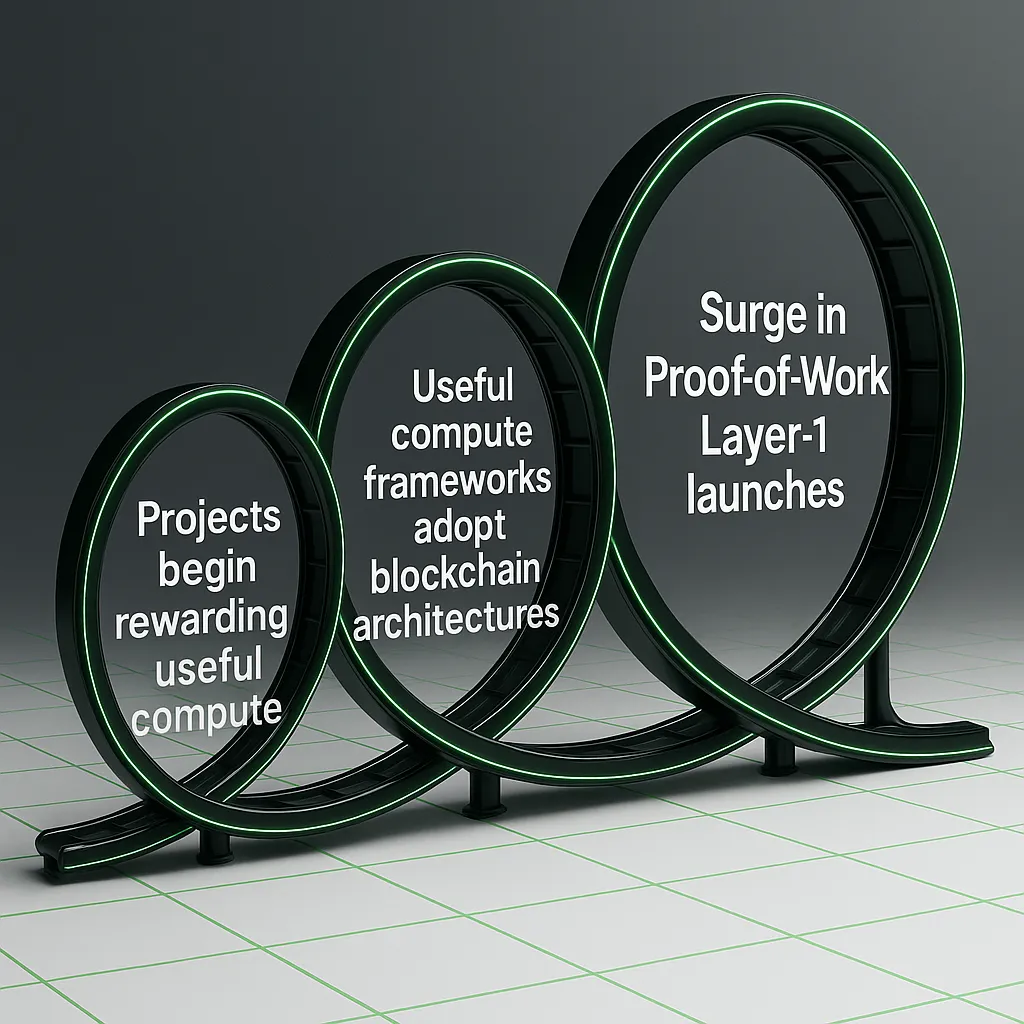
Perhaps most importantly, useful proof of work may offer better token distribution than proof of stake. Rather than wealth concentration through staking, anyone with decent hardware can participate and earn. It’s more aligned with crypto’s decentralization ethos while producing tangible value.
The narrative has flipped completely. Proof of work’s energy consumption was its fatal flaw. Now, that same energy produces AI models, inference results, and zero-knowledge proofs that power the next generation of applications. The miners aren’t just securing networks, they’re building computational infrastructure for a ZK and AI-powered internet.
Not bad for deprecated technology.
HOW W.AI WORKS


Download & Install
Get set up in minutes, it’s so easy your grandma could do it (seriously).

CONNECT & START EARNING
Let your device earn while you work and go about your life.
track your REWARDS
Watch your rewards grow and follow the journey towards an AI future that prioritizes humanity.
FAQ





manifesto

w.ai: The Global AI Supercomputer
The immense power to reshape reality is consolidating within closed labs and datacenters, controlled by narrow interests. This path guarantees fragility, misalignment, and risks a future defined by digital serfdom, not shared progress.
Humanity requires a different foundation. An open, globally distributed compute substrate is not merely preferable; it is the essential architecture for navigating the intelligence explosion safely. The window to build this alternative closes with exponential speed. Delay is abdication.
w.ai is this architecture. It is the open substrate. We are building the peer-to-peer protocol for the Global AI Supercomputer. We are unifying the world’s idle processing power into the planetary foundation necessary for Decentralized Superintelligence (DSI). We move intelligence from silos to the shared mesh.
Trillions of dollars in silicon sit dormant. Billions of devices hold a latent power. This collective force, once awakened, is destined to challenge any single centralized build. w.ai activates this power with a radically simple one-click client engineered for mass adoption. Frictionless contribution, unparalleled reach.
Our singular mission: forge the foundational compute substrate for DSI, ensuring intelligence serves humanity’s collective potential. We begin pragmatically, running real-world AI inference to prove viability and build network density. This establishes the essential base layer for the complex distributed AI tasks ahead.
The future of intelligence must be built, not inherited. Awaken the Global AI Supercomputer with w.ai. Contribute your idle resources. Become a co-owner of this critical infrastructure. Actively participate in building an open intelligence future.
- The w.ai Team
back to top





